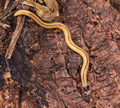| Bipalium vagum | |
|---|---|
 | |
| In La Réunion | |
| Scientific classification | |
| Kingdom: | Animalia |
| Phylum: | Platyhelminthes |
| Order: | Tricladida |
| Family: | Geoplanidae |
| Genus: | Bipalium |
| Species: | B. vagum |
| Binomial name | |
| Bipalium vagum Jones & Sterrer, 2005 | |
Bipalium vagum, the wandering hammerhead worm, is a land planarian in the subfamily Bipaliinae. It has been accidentally introduced in the United States, Bermuda and various islands in the Caribbean [1] [2] [3] and was recorded for the first time in Europe, in Italy, in 2021. [4]


